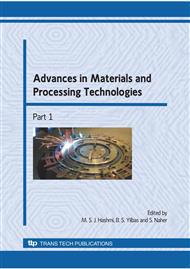[1]
A. Bhattacharya: Metal Cutting Theory and Practice (New Central Book Agency (P) Ltd., Calcutta, 1984).
Google Scholar
[2]
S. Malkin: Grinding Technology-Theory and Application of Machining with Abrasives (Ellis Horwood, New York, 1989).
Google Scholar
[3]
P. K. Kundu, S. Das, S. Sinha and P. P. Chowdhury: On Grinding Wheel Performance in Dry and Wet conditions, Proceedings of the 4 th International Conference on Mechanical Engineering, Dhaka, 2001, pp.19-24.
Google Scholar
[4]
R. S. Sarmacharya, M. N. George and S. Das: On the Grinding Wheel Performance through Minor Wheel Modification, Proceedings of the 18 th AIMTDR Conference, Kharagpur (1998), pp.156-161.
Google Scholar
[5]
S. Ebbrell, N. H. Woolley, Y. D. Tridimas, D. R. Allanson, W. B. Rowe: The Effect of Cutting Fluid Application methods on the Grinding Process, International Journal of Machine Tools & Manufacture, Vol. 40 (2000), pp.209-223.
DOI: 10.1016/s0890-6955(99)00060-7
Google Scholar
[6]
T. Dutta, S. Ghosal and S. Banerjee: Development of a Simple Technique for Enhancing the Fluid Flow through the Grinding Zone, Proceedings of the 21st AIMTDR Conference (2004), pp.109-114.
Google Scholar
[7]
S. Banerjee, S. Ghosal, T. Dutta: Development of Simple Technique for Improving the Efficiency of Fluid Flow through the Grinding Zone, Journal of Materials Processing Technology, Vol. 197(1-3) (2008), pp.306-319.
DOI: 10.1016/j.jmatprotec.2007.06.045
Google Scholar
[8]
F. Engineer, C. Guo and S. Malkin: Experimental Measurement of Fluid Flow Through the Grinding Zone, Journal of Engineering for Industry, Vol. 114 (Issue February 1992), pp.61-66.
DOI: 10.1115/1.2899759
Google Scholar
[9]
K. Ramesh, H. Hunga and L. Yin: Analytical and Experimental Investigation of Coolant Velocity in High Speed Grinding, International Journal of Machine Tools & Manufacture, Vol. 44 (2004), pp.1070-1076.
DOI: 10.1016/j.ijmachtools.2004.02.017
Google Scholar
[10]
R.D. Monici, E.C. Bianchi, R.E. Catai and P.R. de Aguiar: Analysis of The Different Forms of Application and Types of Cutting Fluid Used in Plunge Cylindrical Grinding Using Conventional and Superabrasive CBN Grinding Wheels, International Journal of Machine Tools & Manufacture, Vol. 46 (2006).
DOI: 10.1016/j.ijmachtools.2005.05.009
Google Scholar
[11]
S. Paul and A.B. Chattopadhyay: A Study of Effects of Cryo-Cooling in Grinding, International Journal of Machine Tools & Manufacture, Vol. 36 (1995), pp.109-117.
DOI: 10.1016/0890-6955(95)80010-7
Google Scholar
[12]
S. Paul and A.B. Chattopadhyay: The Effect of Cryogenic Cooling on Grinding Forces, International Journal of Machine Tools & Manufacture, Vol. 46 (2006), pp.63-72.
DOI: 10.1016/0890-6955(95)92629-d
Google Scholar
[13]
T. Nguyen and L.C. Zang: An Asessment of the Applicability of Cold Air and Oil Mist in Surface Grinding, Journal of Materials Processing Technology, Vol. 128 (2002), pp.67-72.
Google Scholar
[14]
H.Z. Choi, S.W. Lee and H.D. Jeong: The Cooling Effects of Compressed Cold Air in Cylindrical Grinding with Alumina and CBN Wheels, Journal of Materials Processing Technology, Vol. 127 (2002), pp.155-158.
DOI: 10.1016/s0924-0136(02)00117-6
Google Scholar
[15]
H.Z. Choi, S.W. Lee and H.D. Jeong: A Comparison of the Cooling Effects of Compressed Cold Air and Coolant for Cylindrical Grinding with a CBN Wheel, Journal of Materials Processing Technology, Vol. 127 (2001), pp.265-268.
DOI: 10.1016/s0924-0136(01)00531-3
Google Scholar
[16]
T. Nguyen and L.C. Zang, An Asessment of the Applicability of Cold Air and Oil Mist in Surface Grinding, Journal of Materials Processing Technology, Vol. 140 (2003), pp.224-230.
DOI: 10.1016/s0924-0136(03)00714-3
Google Scholar
[17]
S. Shaji and V. Radhakrishnan: Application of Solid Lubricants in Grinding: An Investigation on Lubricant Sandwiched Grinding Wheels, Proceedings of the 21st AIMTDR Conference (2004), pp.91-96.
DOI: 10.1081/mst-120018959
Google Scholar
[18]
F.M. White: Viscous Fluid Flow (McGraw-Hill, Inc. Second Edition).
Google Scholar
[19]
D.C. Montgomery: Design and Analysis of Experiments (John Wiley & Sons (Asia) Pte. Ltd., 2005).
Google Scholar
[20]
D.V. Patil: Grindability Study of Inconel 718 using Galvanically Bonded Monolayer cBN Wheel, Ph.D. Thesis, Department of Mechanical Engineering, Indian Institute of Technology Kharagpur, India (2006).
Google Scholar


